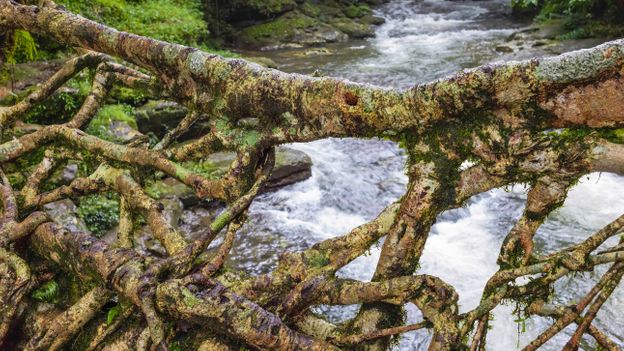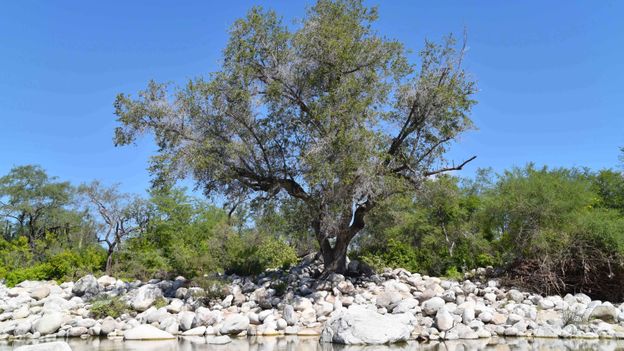Ludwig hopes that living architecture can contribute to improving the outer wellbeing of residents in cities. Integrating trees in buildings, bridges, and parks will help bring nature into crowded areas. “The idea is not to copy the bridges, but to borrow the elements of this indigenous engineering and try to understand how we can adapt it in our urban environments,” says Ludwig.
Julia Watson, architect and assistant professor at Columbia University, whose work revolves around nature-based technologies of indigenous knowledge, says part of this is changing the way we see trees.
“Instead of viewing trees in cities as passive elements, we can view them as active infrastructures, to expand the ecosystem services trees provide in the urban context,” she says. For instance, trees can reduce the effect of urban heat islands (where concrete structures absorb heat and keep cities warmer) and lower outdoor ambient temperature, Watson notes.
The Ficus elastica provides potential that goes far beyond bridges, Watson says. These trees needn’t be an add-on to a building, but an integral part of its façade or roof.
In Meghalaya, the Khasi’s practice of bioengineering takes integration of the trees with their surroundings one step further, bringing people together as well as the ecosystem. The bridges, Lyngdoh says, promote community life and create reverence within the society when people come together to build, maintain and repair the bridges.
The young bridges being trained today won’t be traversed by those who are tending to them now, but by generations to come. “The community doesn’t think of today. It’s a selfless act. It’s a conservation philosophy,” says Lyngdoh. He sees this selflessness as a sacred element that pulls the community together and protects the ecosystem.
As well as being a part of Khasi culture, the root bridges have always brought economic benefits to the community. In the past, a network of bridges connected villages with nearby cities, providing a pathway for locals to transport and sell betel nut and broom grass. Today, there is also the tourism economy they bring, says Syiemlieh.
About 3,500 steps below Syiemlieh’s home village of Tyrna is the Double Decker Root Bridge that connects the two banks of the Umshiang River. When water levels rose high, Khasi villagers trained additional roots of the same fig tree across the river higher above the water, creating a second bridge over the first.
Today, it’s a major tourist attraction. As tourists began flocking, homestays opened. Locals built campsites and guided visitors through the hilly jungle. Makeshift stalls stacked up everything from crisp packets to bottled drinks. In March, when Syiemlieh visited Laitkynsew, a village just south of Tyrna, she saw locals pull, twist and weave aerial roots of a fig tree on bamboo scaffolding to build a triple bridge – two layers run parallel to each another as in the double-decker bridge, while a third root layer is slanted across the river bank. “Maybe they thought that three layers can attract more tourists,” says Syiemlieh.
Tourism comes with concerns, Syiemlieh says. Aside from the empty crisp packets and bottles, some root bridges see crowds of hundreds at a time as tourists clamber for selfies, potentially overburdening the trees. But locals are already planning different models of sustainable tourism.
Khongthaw, for example, is building a museum and a learning centre to educate tourists about living root bridges and other infrastructure made of Ficus elastica, such as canopies and tunnels in the deep jungles, and ladder-like structures, which farmers would use to climb up and down rock ledges on the way to Meghalaya’s fertile plains for cultivation.
Although still in its infancy outside Meghalaya, Watson hopes that architecture inspired by the living root bridges could come to play a fundamental role in cities – bringing with it benefits for urban air, soil and wildlife. “Living infrastructure can support incredible biodiversity and species, not just humans,” Watson says. “We need that biodiversity to survive.”
—
Join one million Future fans by liking us on Facebook, or follow us on Twitter or Instagram.
If you liked this story, sign up for the weekly bbc.com features newsletter, called “The Essential List”. A handpicked selection of stories from BBC Future, Culture, Worklife, Travel and Reel delivered to your inbox every Friday.












